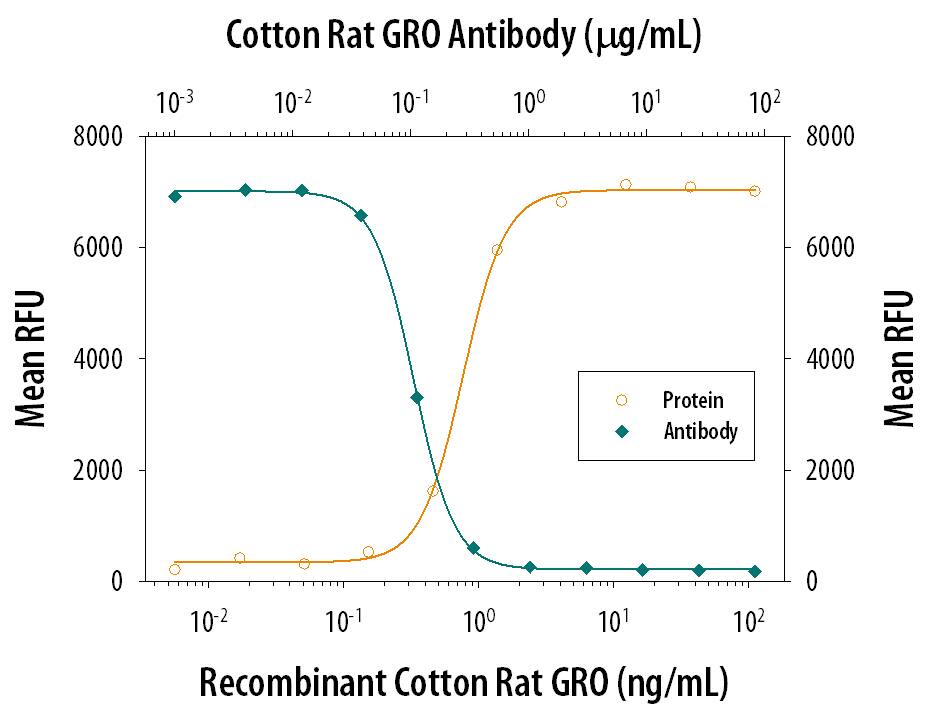Cotton Rat CXCL1/2/3/GRO Antibody
R&D Systems, part of Bio-Techne | Catalog # MAB1114

Key Product Details
Species Reactivity
Applications
Label
Antibody Source
Product Specifications
Immunogen
Ala28-Lys100
Accession # AAL16934
Specificity
Clonality
Host
Isotype
Endotoxin Level
Scientific Data Images for Cotton Rat CXCL1/2/3/GRO Antibody
Chemotaxis Induced by CXCL1/2/3/GRO and Neutralization by Cotton Rat CXCL1/2/3/GRO Antibody.
Recombinant Cotton Rat CXCL1/2/3/GRO (Catalog # 1114-GR) chemoattracts the BaF3 mouse pro-B cell line transfected with human CXCR2 in a dose-dependent manner (orange line). The amount of cells that migrated through to the lower chemotaxis chamber was measured by Resazurin (Catalog # AR002). Chemotaxis elicited by Recombinant Cotton Rat CXCL1/2/3/GRO (5 ng/mL) is neutralized (green line) by increasing concentrations of Cotton Rat CXCL1/2/3/GRO Monoclonal Antibody (Catalog # MAB1114). The ND50 is typically 0.08-0.4 µg/mL.Applications for Cotton Rat CXCL1/2/3/GRO Antibody
Western Blot
Sample: Recombinant Cotton Rat CXCL1/2/3/GRO (Catalog # 1114-GR)
Neutralization
Formulation, Preparation, and Storage
Purification
Reconstitution
Formulation
Shipping
Stability & Storage
- 12 months from date of receipt, -20 to -70 °C as supplied.
- 1 month, 2 to 8 °C under sterile conditions after reconstitution.
- 6 months, -20 to -70 °C under sterile conditions after reconstitution.
Background: CXCL1/2/3/GRO
Cotton rat growth-regulated protein (GRO) is a member of the ELR+ CXC subfamily of chemokines (1). The cotton rat GRO cDNA encodes a 100 amino acid (aa) precursor protein with a 27 aa putative signal peptide and a 73 aa mature protein (2). Among the three human GRO proteins, mature cotton rat GRO is most closely related to CXCL1/GRO alpha, sharing approximately 77% aa sequence identity (3). It also shares 75% and 70% aa sequence identity with mature human CXCL2/GRO beta and CXCL3/GRO gamma, respectively (4). Compared with rat CXC chemokines, mature cotton rat shows 92%, 76%, and 76% aa sequence homology with rat KC/GRO/CINC-1, CINC-2, and CINC-3, respectively (5). Mature cotton rat CXCL1 also shares 74% sequence homology with mature cotton rat MIP-2 (6). Similarly to GRO proteins from other species, cotton rat CXCL1 is expected to be a potent neutrophil chemoattractant and activator. Cotton rat CXCL1 has been shown to bind and activate both mouse chemokine receptors CXCR1 and CXCR2 (7). Similarly to human CXCL1, the cotton rat CXCL1 concentration required to activate CXCR1 is at least an order of magnitude higher than that required to activate CXCR2 (7, 8). Based on studies on rodents, cotton rat CXCL1 is predicted to be produced by a wide variety of cell types including macrophages, endothelial cells, fibroblasts, astrocytes, neutrophils, keratinocytes, and intestinal epithelium (1, 9).
References
- Rollins, B.J. (1997) Blood 90:909.
- Blanco, J.C. et al. (2001) GenBank Accession #: AAL16934.
- Richmond, A. et al. (1988) EMBO J. 7:2025.
- Haskill, S. et al. (1990) Proc. Natl. Acad. Sci. USA 87:7732.
- Nakagawa, H. et al. (1994) Biochem. J. 301:545.
- Blanco, J.C. et al. (2001) GenBank Accession #: AAL26705.
- R&D Systems, unpublished observations.
- Schumacher, C. et al. (1992) Proc. Natl. Acad. Sci. USA 89:10542.
- Zlotnik, A.O. (2000) Immunity 12:121.
Alternate Names
UniProt
Additional CXCL1/2/3/GRO Products
Product Documents for Cotton Rat CXCL1/2/3/GRO Antibody
Product Specific Notices for Cotton Rat CXCL1/2/3/GRO Antibody
For research use only
